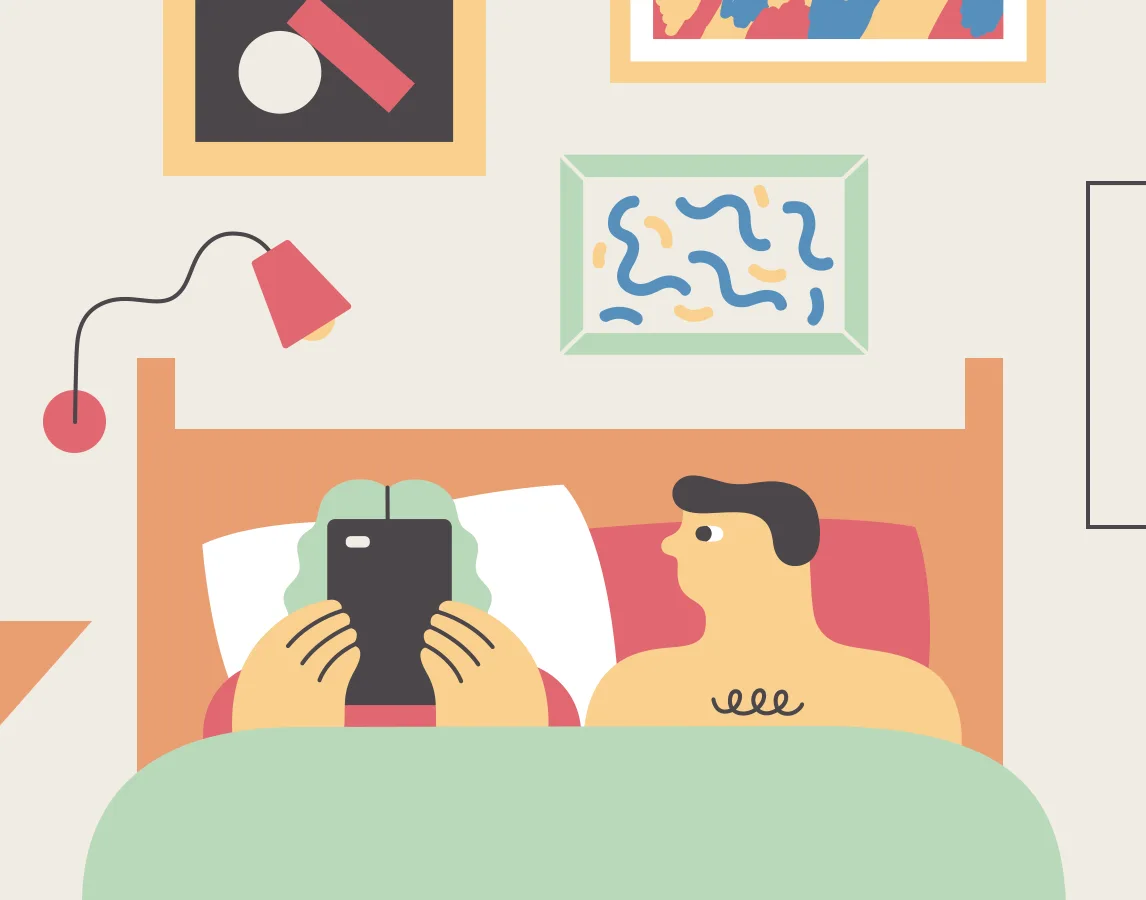What happens when we spend more time with our phones than our people
Diana K.
Jun 14, 2021
Stop me if you’ve heard this one before: you’re sprawled on the couch with your partner, wrapping up the last details of your day. Their response? Silence, punctuated with a tap, tap, tap on a plexiglass screen.
Sound familiar? You’re not alone; smartphones are taking attention away from our partners, causing strife and discontentment in relationships. And our smartphone use isn’t just annoying our partners, it’s stressing us out as well—86 percent of U.S. adults in the recent American Psychological Association's Stress in America: Coping with Change poll results say they constantly or often check their email, texts, and social media accounts. A 2016 article published in the journal Computers in Human Behavior looked at “partner phubbing”—when your partner snubs you in favor of their phone—to examine how this behavior was affecting relationships and personal well-being. Anyone who’s ever been mmhmm'ed while their partner scrolls on their phone can probably guess the article’s conclusions: excessive smartphone use in the presence of our significant others hurts romantic relationships. The article’s authors found that people with anxious attachment styles reported higher levels of cell phone conflict than those with less anxious attachment styles and that phubbing indirectly impacted depression through relationship satisfaction and, ultimately, life satisfaction. I talked with the article’s writer, Dr. James A. Roberts, author of "Too Much of a Good Thing: Are You Addicted to Your Smartphone?", and clinical psychologist Lilli Friedland, Ph.D., on how to handle phubbing.

The history of being ignored in relationships
It’s safe to assume people have been ignored by their significant others for decades, with distractions ranging from newspapers, books, and television. Any leisure activity can take attention away from our partners. So why does it feel more annoying or hurtful when our partners are on tech devices during our time together than if they’re, say, reading a magazine?
The similarity between these distractions is that you’re taking yourself out of the relationship at the moment, says Friedland. “The relationship is based on you and me both having a sense that we're relating, sharing, receiving, and that we're listening. If I'm going to read the paper, you know that obviously I’m not relating at that moment, and it's a clear indication. The phone is different. Once you're on it, you're on it,” she says. In other words, when your partner is reading the paper, you know what is distracting them, but when your partner is on their phone, it’s hard to tell what they’ve deemed more important than interacting with you in that moment. It’s more about whether your partner is looking at you while you’re talking to them so you can read their emotions through their eye gaze and facial expressions to connect, says Friedland. When someone’s eyes are averted, it’s a sign they don’t want to engage. It’s not so much about whether they’re watching TV or scrolling through their emails, it’s about whether they put down what they’re doing and turn their attention to you so you know that they are engaged so you feel attended to, says Friedland. If your partner picks up their phone because a notification went off while you’re talking, it makes you feel like you are not their priority. That could make you question that if you’re not their priority, why are you with them? “If we want to feel closeness in a relationship … the assumption is that this is one of the most important people in the world to me,” says Friedland. “I want to feel safe and connected so that I can be open with some of my vulnerabilities, and I also feel that I have your full attention, so I can talk to you about things.” The basic human needs for control and attachment are at risk when we sense that our partner isn’t present, according to Roberts.
Are you too attached to your phone?
“Our research found that partner phubbing led to cell phone-related conflict that ultimately led to lower levels of reported relationship satisfaction. This is serious because when we are unhappy in love, we look elsewhere for our needs for intimacy. This could lead us to look to others ... to provide what we are not getting at home. But the negative ramifications of phubbing don’t stop there. Our research also found that those who are phubbed also report higher levels of stress and depression,” he says. The APA’s Stress in America survey results supports this, with two-thirds of Americans saying that they “somewhat or strongly agree that periodically ‘unplugging’ or taking a ‘digital detox’ is important for their mental health. However, only 28 percent of those who say this actually report doing so,” according to the press release.
Approaching your partner about their behavior
Before you talk to your partner about how their smartphone use is grinding on your last nerve, Roberts suggests you first examine your own phone behavior. “If you need to improve as well, approach your partner that this is something you need to tackle together. If you point the finger at your partner without taking responsibility for your own behavior, it won’t go over well,” he says. Friedland suggests expressing how you’re feeling rather than simply harping on your significant other’s behavior. Tell your partner that you’d like to try an experiment where you both give each other undivided attention for 20 minutes or so each evening. “You could say, ‘This makes me feel closer, and better able to understand where you're coming from, to meet your needs, and feel more connected,’” she suggests. Friedland says these conversations work best when you can clearly see each other’s faces. Paying attention to your partner’s facial expressions can help you better understand how you’re communicating and whether something was well received. Once you notice your partner curbing their smartphone use around you, remember to thank them for their efforts and let them know that you appreciate their willingness to change. “Positive reinforcement is a cornerstone to encouraging desired behaviors,” says Roberts.
How to reduce smartphone use
Set “smartphone free” zones and times when smartphone use is forbidden, suggests Roberts. Examples might include at dinner, during family time, on dates or family outings, and certainly in the bedroom. “You can also use what I call, ‘The hair of the dog’ to cut down on your smartphone use, which entails using apps to monitor—and even restrict—your smartphone use,” says Roberts. You can also draw up a social contract where you set out the dos and don’ts for your smartphone use including penalties for breaking the contract, suggests Roberts. “Psychologists have used social contacts for 100 years to help modify behavior,” he says. It could simply be a contract between you and your partner or an online service where you define your goals. Try giving your partner your full attention for at least a half an hour a day, without the distractions of phones, or television, and see if the nature of your conversations changes, suggests Friedland. “In terms of feeling engaged, and being able to really talk about things—even if it’s just how your day was—it will make your partner feel more connected. I've never heard of any of my patients doing this who said it didn’t add that level of connectedness.” Utilizing the “Do No Disturb” setting on your phone can also prevent interruptions. You might want to change the settings to “Allow Calls From” and add certain family members or “Favorites” there so you’ll get an important call that needs to be answered. Otherwise, turn off your social media notifications, emails, and text message notifications, and give your partner some undivided attention for a few moments a day—you’ll both reap the rewards.


Be kind to your mind
- Access the full library of 500+ meditations on everything from stress, to resilience, to compassion
- Put your mind to bed with sleep sounds, music, and wind-down exercises
- Make mindfulness a part of your daily routine with tension-releasing workouts, relaxing yoga, Focus music playlists, and more
Annual - billed at $69.99 USD/yr
14 days free
$5.83 USD/month
Monthly
7 days free
$12.99 USD/month

Meditation and mindfulness for any mind, any mood, any goal

Stay in the loop
Be the first to get updates on our latest content, special offers, and new features.
By signing up, you’re agreeing to receive marketing emails from Headspace. You can unsubscribe at any time. For more details, check out our Privacy Policy.
- © 2025 Headspace Inc.
- Terms & conditions
- Privacy policy
- Consumer Health Data
- Your privacy choices
- CA Privacy Notice







